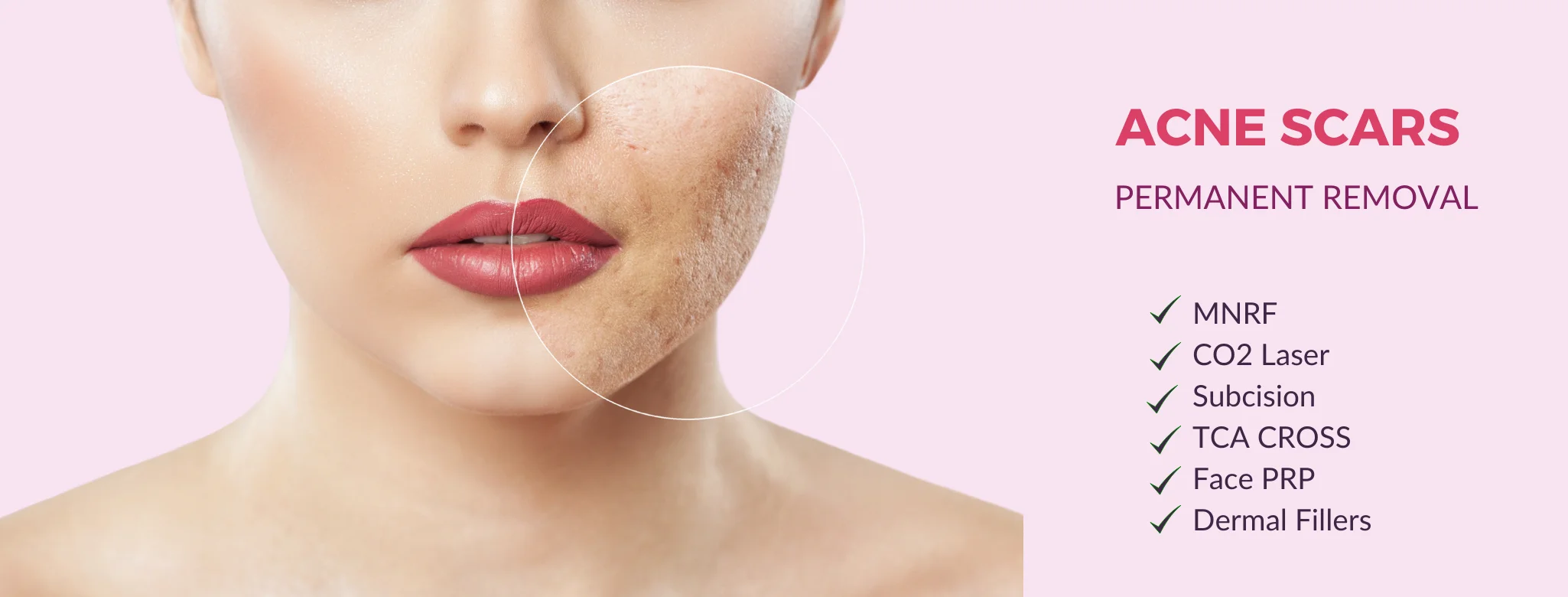
Acne Scar Treatment in Delhi
Acne eruptions can be frustrating enough, but the scar tissue that acne leaves behind feels really awful. Acne scars reduce one’s quality of life and have significant emotional and psychological effects leading to social embarrassment and withdrawal, decreased confidence, low self-esteem, and depression.
It is important to understand, educating and creating awareness that before starting the treatment for acne scars, you should first treat the acne since new acne can lead to new scars and thus defeat the entire goal of treating acne scarring.
What are acne scars?
Acne scars are irregularities in the skin surface occurring after the healing of acne lesions. They are seen as holes and depressions in the skin, varying in shape, size, and depth.
They are classified into different acne scars, namely, ice-pick scars, rolling scars, and boxcar scars. These are types of atrophic scars. In some individuals, acne may also result in raised and thick scars, such as hypertrophic scars, raised scars, or keloidal. Keloidal scars are more common in type 4 and above skin type.
Why do they occur?
Acne scars occur as a result of skin inflammation associated with deep and severe acne.
When the skin heals and attempts to repair these deep lesions, it heals by forming new collagen fibers. These repairs usually aren't as smooth and flawless as the original skin, causing acne scarring.
Popping or scratching the acne lesions can also increase the chance of scarring.
How are acne scars different from acne spots?
Acne scars are different than dark spots from acne. It is vital to understand this concept of the healing process by all acne scar patients.
Scars are irregularities in the skin surface seen as holes and depressions. There can be elevated acne scars as well. Scars require tissue to be damaged or overgrown. Scars are difficult to remove fully, and while they may fade over time, they usually remain visible.
Whereas acne spots or dark spots from acne are flat lesions. They don’t indicate any long-term damage to your skin cells, pores, or follicles. It can take some time, but dark spots become lighter with duration and eventually go away completely. It can take anywhere from 3 months to 2 years for them to vanish from view.
How to identify ice pick scars?
Ice pick scars are more deep than wide. They are narrow (usually less than 2mm in diameter) with deep vertical walls, wide at the surface and narrow at the base.
How to identify rolling scars?
These acne scars are distensible depressed scars with sloping edges, usually wider than 4-5mm.
How to identify boxcar scars?
Boxcar scars are circular depressions with sharply defined vertical edges. They vary in depth and diameter from 1.5 - 4mm.
Who is a good candidate for acne scar treatment?
Anyone who is positively motivated and wants to improve their aesthetic appearance can undergo acne scar treatment. People with active acne lesions are not suitable for scar treatment procedures. It is advisable first to get the acne treated and then proceed for scar improvement in such cases.
How can I get rid of acne scars?
Acne scar removal treatment methods are many, and the choice of treatment for acne scars depends on the types and severity of scars. Because no one ever has just one type of scar, a combination of different acne scar treatments is usually required for complete acne scar removal.
Options for mild acne scarring include:
Microdermabrasion - applies tiny rough particles from a special machine to remove the top layer of skin. Skin conditions with superficial acne scars can be treated by microdermabrasion.
Moderate to severe acne scars can benefit from the following procedures:
Dermabrasion - is the surgical removal or exfoliation of the outer layer of skin on acne scars.
Microneedling - Micro-needling with derma roller is a procedure that uses small needles to create controlled micro-injury to the skin. This helps to stimulate the body’s own collagen production and smooth acne scarring.
Microneedling radiofrequency - MNRF: MNRF, the most popular of all types of acne scar treatment. It is more suitable for Indian Skin types as the risk of post-inflammatory hyperpigmentation is minimal with MNRF.
Laser Scar Treatment - Fractional laser treatment for acne scars uses a focussed beam of light to treat the acne, simultaneously preserving the normal surrounding tissue. It works best when combined with other modalities of treatment.
Laser Resurfacing - uses a laser to remove the scarred upper layers of skin and encourage new healthy collagen to grow in its place. A skin treatment for overall improvement in the skin's texture is also used as an anti-aging treatment.
Subcision - is a simple and common skin procedure, low-cost solution to severe acne scarring whereby a needle is used to break apart the fibrous bands of tissue that prevent the skin from laying in its natural position.
TCA CROSS - This is a type of chemical peel used for icepick scars. A type of Chemical peeling treatment for acne scars can be used for mild to moderate ice pick scars.
Dermal fillers - improve the skin’s appearance by injecting a filler directly into the acne scar.
Excision and punch replacement graft - involves cutting into the skin to remove the acne scar and then stitching the wound. The scar is removed with a special tool in punch replacement grafting, and a skin graft – usually taken from behind the ear – fills the wound.
What is the best acne scar treatment option?
There is no single best treatment. What will give you the best results will depend on the type and severity of your scars. So it is highly recommended that you visit an experienced dermatologist for careful assessment and detailed discussion about the therapeutic options.
When can I expect the results?
You can start to notice changes after the first session itself. Collagen remodeling is a gradual and continuous process, so the improvement continues to occur for up to one year after the treatment ends. Can appreciate best results at the end of 9-12 months.
Can I get a complete healing of scars?
You can start to notice changes after the first session itself. Collagen remodeling is a gradual and continuous process, so the improvement continues to occur for up to one year after the treatment ends. Can appreciate best results at the end of 9-12 months.
Are the results permanent?
Yes. The results you get after the completion of treatment are permanent.
How can I prevent acne scars?
The best way to prevent scar formation is to get your acne treated during the early stages to minimize inflammation's extent and duration, which reduces scarring.
Is laser treatment for acne scars permanent?
Yes! The results of laser treatment are permanent. However, it is important to note that a complete laser treatment cycle takes about 6 to 8 sessions for the best result.
What's the laser treatment for acne scar cost?
Laser acne scar removal cost in Delhi ranges from Rs.6000 to 12000 pr session.
Laser acne scar treatment cost in Delhi is based on many factors such as:
Laser Machine - Fractional CO2 ablative or Fractional Non Ablative laser
US FDA Approved Laser Machine: You must always check if the laser machine used is US FDA approved or not. This indicates the safety profile of the laser machine used for treatment. The laser machine used at skinos is Lumenis ResurfX, the best laser machine in the world for treating mild to severe acne scars.
Doctor Qualification And Expertise: Always check if the treating dermatologist holds a qualified medical degree from recognized medical colleges and universities.
Infrastructure: Skinos is spread over a 2000sq ft area and has the best services and hospitality in the healthcare industry.
The surface area of treatment: This is important as this will determine how many laser shots are consumed in treating the area per session.
Type of acne scar treatment: This helps us know if there will be one type of treatment required or there will be a requirement of combinations of treatment.
How to select the best skin clinic for acne scar treatment?
Skinos is the best laser acne scar removal clinic in Delhi for all types of acne scars treatment. If you are looking for the best clinic for acne scar treatment in Delhi,
We thoroughly analyze the type of acne scar at consultation with our dermatologists and formulate the most effective treatment plan during the discussion and after understanding your expectations. Undoubtedly Dr.Shruti Gupta, MD, FAAD (USA), is the best skin doctor for acne scars treatment in Delhi. Dr.Shruti Gupta has treated over 15000 patients for almost a decade with consistent 100% client satisfaction in her practice.
Finding the best acne scar treatment near me? Skinos has the most powerful and latest US FDA-approved laser technologies to treat acne scars with assured results effectively. We always aspire to be the best acne scar treatment clinic in Delhi using our latest technology and advanced skincare treatments.
Frequently Asked Questions on:
We always attempt to heal our acne breakouts quickly and early through various home remedies, but they always leave behind blemishes on the skin in the form of dark brown or black spots, which are all the more frustrating!
When a pimple pops up on your skin, it’s technically a form of inflammation due to clogged pores with dead skin cells and sebum. As your skin heals and new skin cells form, the cells sent to help restore your smooth skin surface may contain too much melanin.
Melanin is what gives your skin its color, and when certain cells that have more melanin than others give rise to a darker patch of skin. This is called post-inflammatory hyperpigmentation. This can be further worsened with prolonged sun exposure.
Acne spots are widespread whenever the skin inflammation is prolonged, like popping or squeezing the acne. Using an irritant product for skincare, the chances of developing post-inflammatory hyperpigmentation increase—a type of skin disease with multiple pigmented spots on the face.
People who have naturally darker skin tones are more prone to this condition.
Dark spots developed due to acne lesions are different from acne scars. These are different types of acne problems.
Scars are the irregularities in the layers of skin surface seen as holes and depressions. Sometimes, there could be elevated scar tissue. Scars require tissue to be damaged or overgrown. Treating Acne Scars are difficult, and while they may fade over time, they usually remain visible.
(On the other hand, Acne marks are flat lesions. They don’t indicate any long-term damage to your skin cells, pores, or follicles. Dark spots tend to become lighter over time and eventually go away completely. It can take anywhere from 3 months to 2 years for them to disappear on their own.
Topical products containing active ingredients stop melanin synthesis in dark spots while peeling off old skin and encouraging new cell formation.
A more effective and quicker way to get rid of acne spots is through physical treatment modalities and products as per medical advice.
These therapies include:
- Chemical peels with salicylic acid acid
- Microdermabrasion
- Laser treatment
- Light Therapy
- Medi Facial
- Carbon facial
- Photofacial
- Face PRP
Combining one or more of the above-mentioned therapeutic options can remove the acne spots in few months
The best way to prevent dark spots is to seek treatment for your acne early. You should avoid breaking your acne. Avoid applying any products that cause skin irritation and inflammation.
Use of a broad-spectrum sunscreen regularly should be practiced.
You should follow all advice from the dermatologist to help prevent acne spots.
If you do not seek any active treatment for acne spots, they tend to fade away on their own over a period of 3 months to 2 years.
Using any topical products can reduce healing time to 6-9 months, and with added treatment, dark spots can vanish in as little as 3 months.
The following are the home remedies to get rid of acne spots:
- Coconut Oil: Its anti-bacterial and anti-inflammatory properties can be used on the spots and left overnight for best results.
- Lemon Juice: Applying a small amount of fresh lemon juice on the spots for 10-15 minutes and wash your face later with lukewarm water.
- Turmeric: It's an ancient medical way of treating acne spots. 1 teaspoon of turmeric is mixed with a small amount of lemon juice to form a paste. This paste is applied over the spots as a mask for over 30 minutes. Due to its anti-inflammatory action, it helps in lightening the spots.
- Castor Oil: It helps in new cell growth on the skin. It is applied overnight on the spots and washed off using lukewarm water.
- Aloe Vera: Aloe Vera is an anti-inflammatory substance, and due to this property, it's widely used to treat acne blemishes and spots. It is applied overnight daily for better results.
- Orange Powder: Orange Peel is formed by mixing the orange powder with honey. This orange peel powder is applied to the spots for 15-20 minutes and washed with lukewarm water.
- Are the repeated dark spots causing anxiety and psychological distress?
- Is it affecting both your personal and professional life?
- Do you feel less confident than before?
- Are you are not able to perform a simple daily routine?
- Do you think you are socially withdrawn?
- If the answer to all these questions is yes, then you may want to consult a Dermatologist.
- A Dermatologist with whom you can bond well enough to discuss your psychological and physical distress in greater depth.
A dermatologist helps you through your problem and advises you of the USA FDA-approved treatments as per medical guidelines. With them, you can be fully sure of assured results and support.
What Our Patients Say
Nothing gives us more pleasure than the happiness and gratitude expressed by our clients at the end of their Skin, Hair, and Laser treatment!

I recommend Dr. Shruti Gupta because she explains everything related to my problems patiently and p...
Divya Sonkar
Studentaaa
First of all I would like to thank Dr Shruti Gupta Mam for giving me a new life. On the advice of my...
Dinesh
DU Student
Dr.Shruti is very humble and adorable to everyone she explains everything wonderfully, and answers a...
Mukta Rathee
MBBS Student
It was a pleasant experience. Your work is par above my expectations. My exuberant hair growth gives...
Mohit Shukla
DJ
I have acne issue from last 13 year's I tried all from the to homemade solution but nothing's work a...
Sonal Wahi
SQ - CA25000 +
Happy Clients
5
Qualified Doctors
9
Luxury Suites
50 +
Authorized Partners

